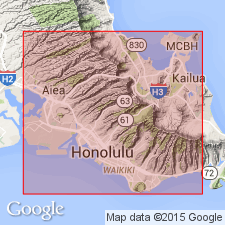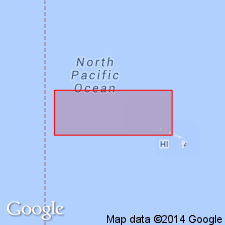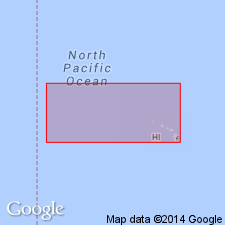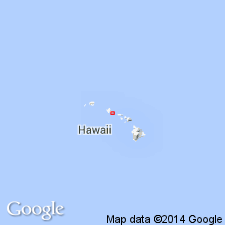
- Usage in publication:
-
- Kaimuki basalt
- Modifications:
-
- Named
- Dominant lithology:
-
- Basalt
- AAPG geologic province:
-
- Oahu
Summary:
Named for Kaimuki spur [hill about mi N of Diamond Head, Honolulu 7.5' quad] Island of Oahu. Sketch map of Diamond Head area shows extent. Composed of basalt which varies from dense rock nearly free from vesicles to very scoriaceous material with abundant cavities 2 cm in diameter. Is strewn with rough, pitted blocks weathered to deep red color. Overlies Diamond Head tuff. Younger than Diamond Head tuff.
Source: GNU records (USGS DDS-6; Menlo GNULEX).

- Usage in publication:
-
- Kaimuki volcanics*
- Modifications:
-
- Age modified
- Redescribed
- AAPG geologic province:
-
- Oahu
Summary:
Kaimuki basalt of Wentworth (1926) is called Kaimuki volcanics and included as unit in middle part of Honolulu volcanic series. Lava is a vesicular olivine pahoehoe basalt as much as 200 ft thick near center but only 4 to 8 ft thick at Kapahulu quarry. Underlies calcareous beach material of Waimanalo stand of sea. Apparently basalt erupted during Waipio stand of sea. Assigned middle(?) and late Pleistocene age.
Source: GNU records (USGS DDS-6; Menlo GNULEX).

- Usage in publication:
-
- Kaimuki volcanics*
- Modifications:
-
- Age modified
- AAPG geologic province:
-
- Oahu
Summary:
Covers area about 2 sq mi on south side of Koolau Range about 10 mi west of Makapuu Head. Type locality: Kaimuku Hill [about 1 mi north of Diamond Head [21 deg 16' 58"N, 157 deg 48' 06"W, Honolulu 7.5' quad] Island of Oahu. Underlies marine limestone of plus 25-ft [Waimanalo] stand of sea and lithified calcareous sand dunes of minus 60-ft (Waipio) stand. Assigned late Pleistocene age based on stratigraphic relations to Waipio stand of sea.
Source: GNU records (USGS DDS-6; Menlo GNULEX).

- Usage in publication:
-
- Kaimuki Lava
- Modifications:
-
- Geochronologic dating
- AAPG geologic province:
-
- Oahu
Summary:
K-Ar ages on samples of nepheline-basanite from Kaimuki Lava [Kaimuki Basalt of Wentworth, 1926] range from 289 +/-7 ka to 272 +/-10 ka.
Source: GNU records (USGS DDS-6; Menlo GNULEX).

- Usage in publication:
-
- Kaimuki Basalt†
- Modifications:
-
- Abandoned
- AAPG geologic province:
-
- Oahu
Summary:
Kaimuki Basalt (Wentworth, 1926) and Kaimuki Volcanics (Stearns, IN Stearns and Vaksvik, 1935) abandoned as formally named units and called Kaimuki flows, informal unit of Honolulu Volcanics.
Source: GNU records (USGS DDS-6; Menlo GNULEX).
For more information, please contact Nancy Stamm, Geologic Names Committee Secretary.
Asterisk (*) indicates published by U.S. Geological Survey authors.
"No current usage" (†) implies that a name has been abandoned or has fallen into disuse. Former usage and, if known, replacement name given in parentheses ( ).
Slash (/) indicates name conflicts with nomenclatural guidelines (CSN, 1933; ACSN, 1961, 1970; NACSN, 1983, 2005, 2021). May be explained within brackets ([ ]).

